Thematic Analysis of Women's Health in UK Prisons: Case Study
VerifiedAdded on 2023/06/10
|35
|6265
|406
Case Study
AI Summary
This qualitative small case study investigates the perception of the provision and needs concerning the Health and Well-being for women in prison (UK). Conducted through online structured interviews and analyzed using deductive thematic analysis, the study explores the main issues faced by women in prison, including their rights, healthcare access, and specific challenges related to transgender prisoners and mothers. The research aims to compare legal provisions with public perceptions to identify areas for improvement and future research. Findings suggest that the participants' perception of well-being provision matches government legislation. The study highlights themes such as prison experience, reasons for incarceration, perceptions of treatment, the purpose of prison (punishment vs. rehabilitation), women's mental health issues, and areas needing improvement, including prisoners' rights, issues related to motherhood, and transgender concerns. The study also acknowledges the impact of the COVID-19 pandemic on research and interviews.
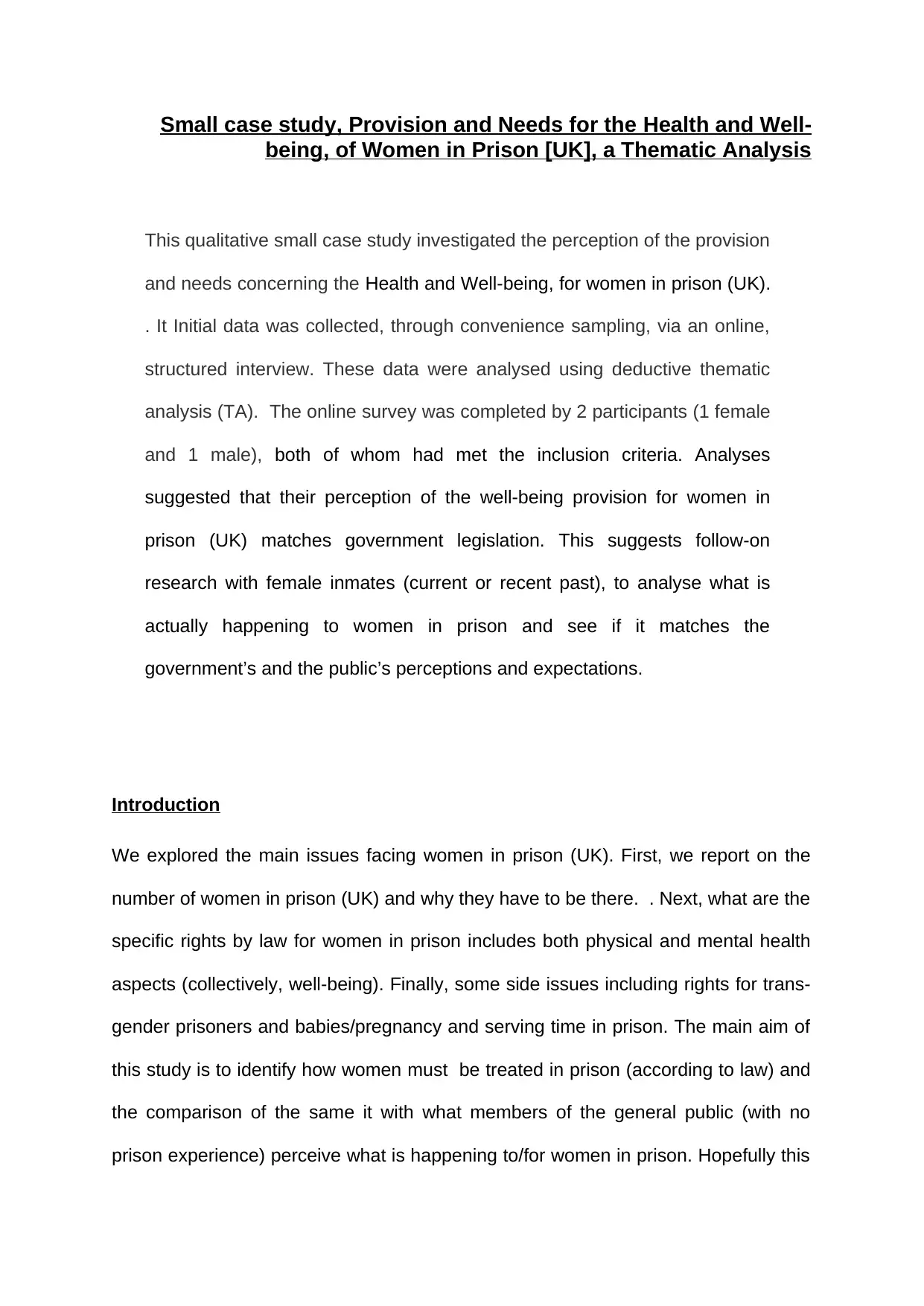
Small case study, Provision and Needs for the Health and Well-
being, of Women in Prison [UK], a Thematic Analysis
This qualitative small case study investigated the perception of the provision
and needs concerning the Health and Well-being, for women in prison (UK).
. It Initial data was collected, through convenience sampling, via an online,
structured interview. These data were analysed using deductive thematic
analysis (TA). The online survey was completed by 2 participants (1 female
and 1 male), both of whom had met the inclusion criteria. Analyses
suggested that their perception of the well-being provision for women in
prison (UK) matches government legislation. This suggests follow-on
research with female inmates (current or recent past), to analyse what is
actually happening to women in prison and see if it matches the
government’s and the public’s perceptions and expectations.
Introduction
We explored the main issues facing women in prison (UK). First, we report on the
number of women in prison (UK) and why they have to be there. . Next, what are the
specific rights by law for women in prison includes both physical and mental health
aspects (collectively, well-being). Finally, some side issues including rights for trans-
gender prisoners and babies/pregnancy and serving time in prison. The main aim of
this study is to identify how women must be treated in prison (according to law) and
the comparison of the same it with what members of the general public (with no
prison experience) perceive what is happening to/for women in prison. Hopefully this
being, of Women in Prison [UK], a Thematic Analysis
This qualitative small case study investigated the perception of the provision
and needs concerning the Health and Well-being, for women in prison (UK).
. It Initial data was collected, through convenience sampling, via an online,
structured interview. These data were analysed using deductive thematic
analysis (TA). The online survey was completed by 2 participants (1 female
and 1 male), both of whom had met the inclusion criteria. Analyses
suggested that their perception of the well-being provision for women in
prison (UK) matches government legislation. This suggests follow-on
research with female inmates (current or recent past), to analyse what is
actually happening to women in prison and see if it matches the
government’s and the public’s perceptions and expectations.
Introduction
We explored the main issues facing women in prison (UK). First, we report on the
number of women in prison (UK) and why they have to be there. . Next, what are the
specific rights by law for women in prison includes both physical and mental health
aspects (collectively, well-being). Finally, some side issues including rights for trans-
gender prisoners and babies/pregnancy and serving time in prison. The main aim of
this study is to identify how women must be treated in prison (according to law) and
the comparison of the same it with what members of the general public (with no
prison experience) perceive what is happening to/for women in prison. Hopefully this
Paraphrase This Document
Need a fresh take? Get an instant paraphrase of this document with our AI Paraphraser
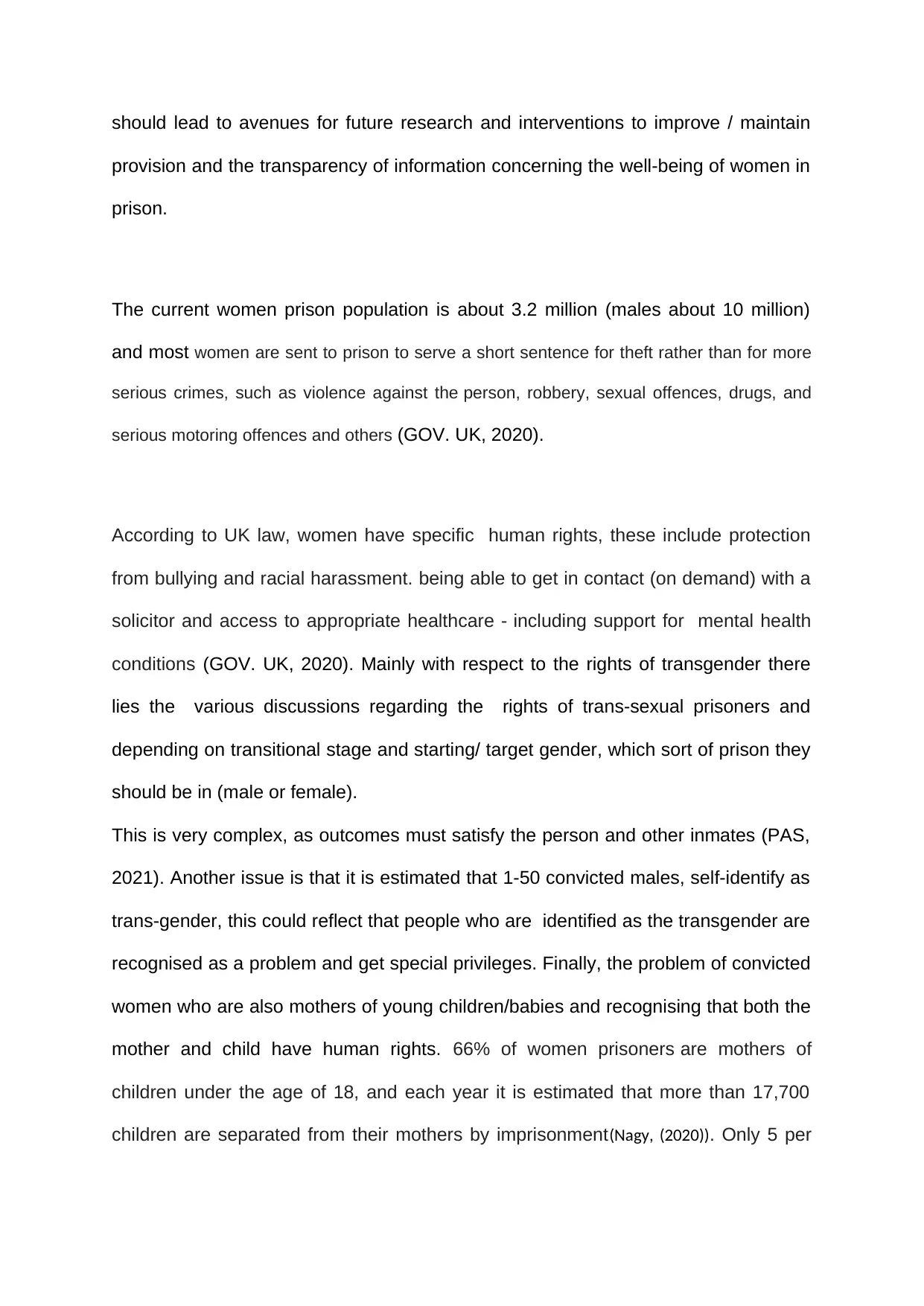
should lead to avenues for future research and interventions to improve / maintain
provision and the transparency of information concerning the well-being of women in
prison.
The current women prison population is about 3.2 million (males about 10 million)
and most women are sent to prison to serve a short sentence for theft rather than for more
serious crimes, such as violence against the person, robbery, sexual offences, drugs, and
serious motoring offences and others (GOV. UK, 2020).
According to UK law, women have specific human rights, these include protection
from bullying and racial harassment. being able to get in contact (on demand) with a
solicitor and access to appropriate healthcare - including support for mental health
conditions (GOV. UK, 2020). Mainly with respect to the rights of transgender there
lies the various discussions regarding the rights of trans-sexual prisoners and
depending on transitional stage and starting/ target gender, which sort of prison they
should be in (male or female).
This is very complex, as outcomes must satisfy the person and other inmates (PAS,
2021). Another issue is that it is estimated that 1-50 convicted males, self-identify as
trans-gender, this could reflect that people who are identified as the transgender are
recognised as a problem and get special privileges. Finally, the problem of convicted
women who are also mothers of young children/babies and recognising that both the
mother and child have human rights. 66% of women prisoners are mothers of
children under the age of 18, and each year it is estimated that more than 17,700
children are separated from their mothers by imprisonment(Nagy, (2020)). Only 5 per
provision and the transparency of information concerning the well-being of women in
prison.
The current women prison population is about 3.2 million (males about 10 million)
and most women are sent to prison to serve a short sentence for theft rather than for more
serious crimes, such as violence against the person, robbery, sexual offences, drugs, and
serious motoring offences and others (GOV. UK, 2020).
According to UK law, women have specific human rights, these include protection
from bullying and racial harassment. being able to get in contact (on demand) with a
solicitor and access to appropriate healthcare - including support for mental health
conditions (GOV. UK, 2020). Mainly with respect to the rights of transgender there
lies the various discussions regarding the rights of trans-sexual prisoners and
depending on transitional stage and starting/ target gender, which sort of prison they
should be in (male or female).
This is very complex, as outcomes must satisfy the person and other inmates (PAS,
2021). Another issue is that it is estimated that 1-50 convicted males, self-identify as
trans-gender, this could reflect that people who are identified as the transgender are
recognised as a problem and get special privileges. Finally, the problem of convicted
women who are also mothers of young children/babies and recognising that both the
mother and child have human rights. 66% of women prisoners are mothers of
children under the age of 18, and each year it is estimated that more than 17,700
children are separated from their mothers by imprisonment(Nagy, (2020)). Only 5 per
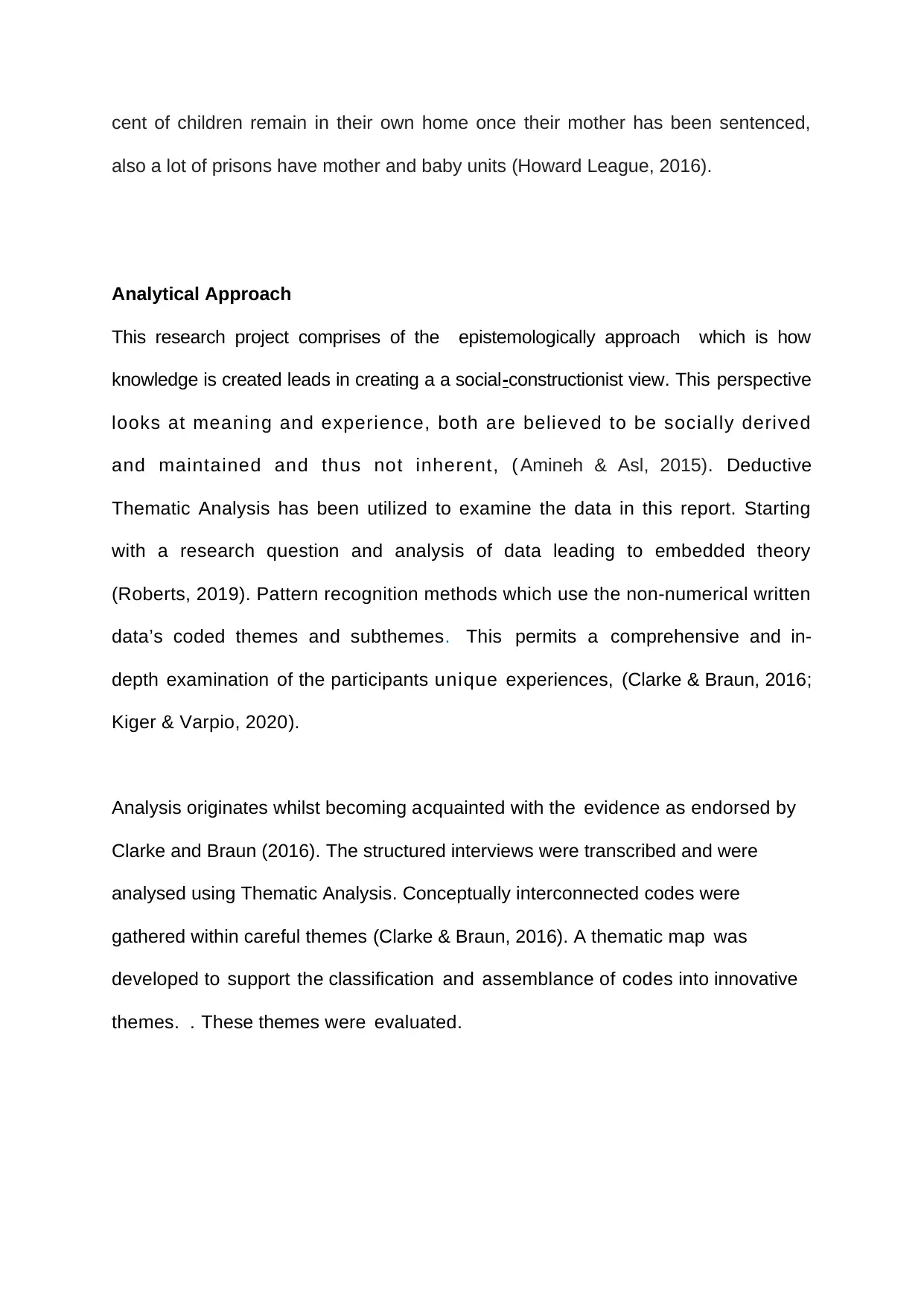
cent of children remain in their own home once their mother has been sentenced,
also a lot of prisons have mother and baby units (Howard League, 2016).
Analytical Approach
This research project comprises of the epistemologically approach which is how
knowledge is created leads in creating a a social-constructionist view. This perspective
looks at meaning and experience, both are believed to be socially derived
and maintained and thus not inherent, ( Amineh & Asl, 2015). Deductive
Thematic Analysis has been utilized to examine the data in this report. Starting
with a research question and analysis of data leading to embedded theory
(Roberts, 2019). Pattern recognition methods which use the non-numerical written
data’s coded themes and subthemes. This permits a comprehensive and in-
depth examination of the participants unique experiences, (Clarke & Braun, 2016;
Kiger & Varpio, 2020).
Analysis originates whilst becoming acquainted with the evidence as endorsed by
Clarke and Braun (2016). The structured interviews were transcribed and were
analysed using Thematic Analysis. Conceptually interconnected codes were
gathered within careful themes (Clarke & Braun, 2016). A thematic map was
developed to support the classification and assemblance of codes into innovative
themes. . These themes were evaluated.
also a lot of prisons have mother and baby units (Howard League, 2016).
Analytical Approach
This research project comprises of the epistemologically approach which is how
knowledge is created leads in creating a a social-constructionist view. This perspective
looks at meaning and experience, both are believed to be socially derived
and maintained and thus not inherent, ( Amineh & Asl, 2015). Deductive
Thematic Analysis has been utilized to examine the data in this report. Starting
with a research question and analysis of data leading to embedded theory
(Roberts, 2019). Pattern recognition methods which use the non-numerical written
data’s coded themes and subthemes. This permits a comprehensive and in-
depth examination of the participants unique experiences, (Clarke & Braun, 2016;
Kiger & Varpio, 2020).
Analysis originates whilst becoming acquainted with the evidence as endorsed by
Clarke and Braun (2016). The structured interviews were transcribed and were
analysed using Thematic Analysis. Conceptually interconnected codes were
gathered within careful themes (Clarke & Braun, 2016). A thematic map was
developed to support the classification and assemblance of codes into innovative
themes. . These themes were evaluated.
⊘ This is a preview!⊘
Do you want full access?
Subscribe today to unlock all pages.

Trusted by 1+ million students worldwide
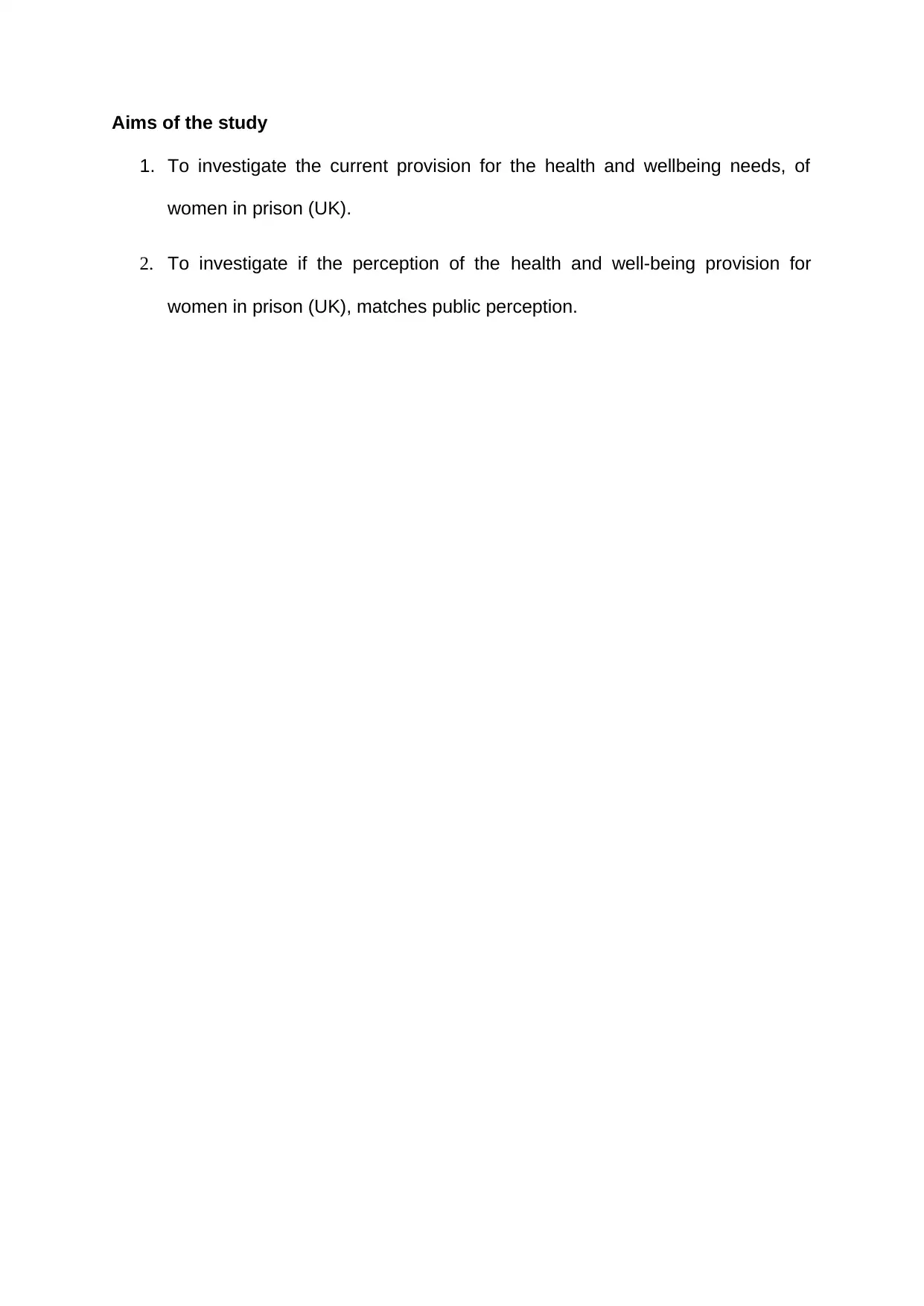
Aims of the study
1. To investigate the current provision for the health and wellbeing needs, of
women in prison (UK).
2. To investigate if the perception of the health and well-being provision for
women in prison (UK), matches public perception.
1. To investigate the current provision for the health and wellbeing needs, of
women in prison (UK).
2. To investigate if the perception of the health and well-being provision for
women in prison (UK), matches public perception.
Paraphrase This Document
Need a fresh take? Get an instant paraphrase of this document with our AI Paraphraser
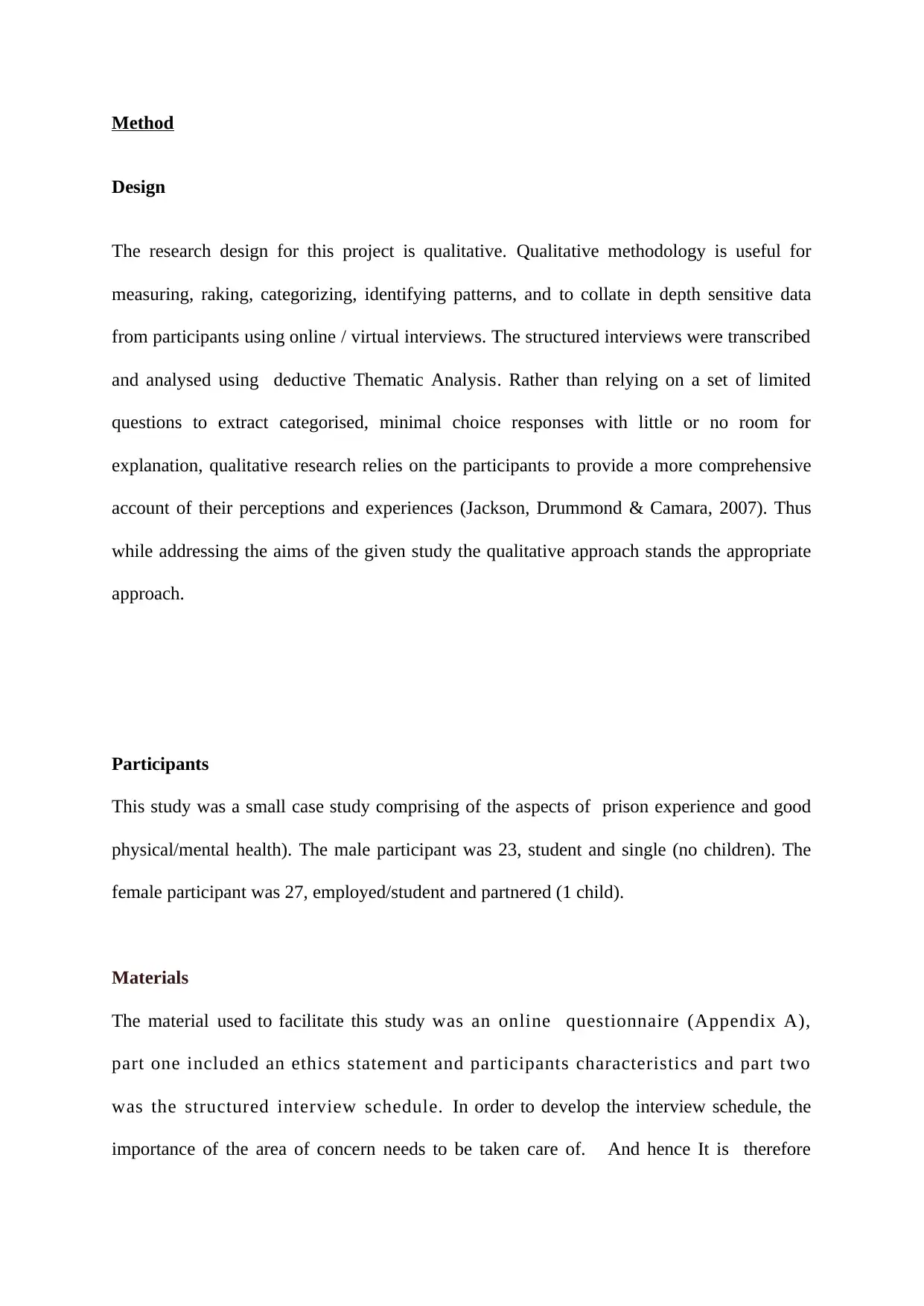
Method
Design
The research design for this project is qualitative. Qualitative methodology is useful for
measuring, raking, categorizing, identifying patterns, and to collate in depth sensitive data
from participants using online / virtual interviews. The structured interviews were transcribed
and analysed using deductive Thematic Analysis. Rather than relying on a set of limited
questions to extract categorised, minimal choice responses with little or no room for
explanation, qualitative research relies on the participants to provide a more comprehensive
account of their perceptions and experiences (Jackson, Drummond & Camara, 2007). Thus
while addressing the aims of the given study the qualitative approach stands the appropriate
approach.
Participants
This study was a small case study comprising of the aspects of prison experience and good
physical/mental health). The male participant was 23, student and single (no children). The
female participant was 27, employed/student and partnered (1 child).
Materials
The material used to facilitate this study was an online questionnaire (Appendix A),
part one included an ethics statement and participants characteristics and part two
was the structured interview schedule. In order to develop the interview schedule, the
importance of the area of concern needs to be taken care of. And hence It is therefore
Design
The research design for this project is qualitative. Qualitative methodology is useful for
measuring, raking, categorizing, identifying patterns, and to collate in depth sensitive data
from participants using online / virtual interviews. The structured interviews were transcribed
and analysed using deductive Thematic Analysis. Rather than relying on a set of limited
questions to extract categorised, minimal choice responses with little or no room for
explanation, qualitative research relies on the participants to provide a more comprehensive
account of their perceptions and experiences (Jackson, Drummond & Camara, 2007). Thus
while addressing the aims of the given study the qualitative approach stands the appropriate
approach.
Participants
This study was a small case study comprising of the aspects of prison experience and good
physical/mental health). The male participant was 23, student and single (no children). The
female participant was 27, employed/student and partnered (1 child).
Materials
The material used to facilitate this study was an online questionnaire (Appendix A),
part one included an ethics statement and participants characteristics and part two
was the structured interview schedule. In order to develop the interview schedule, the
importance of the area of concern needs to be taken care of. And hence It is therefore
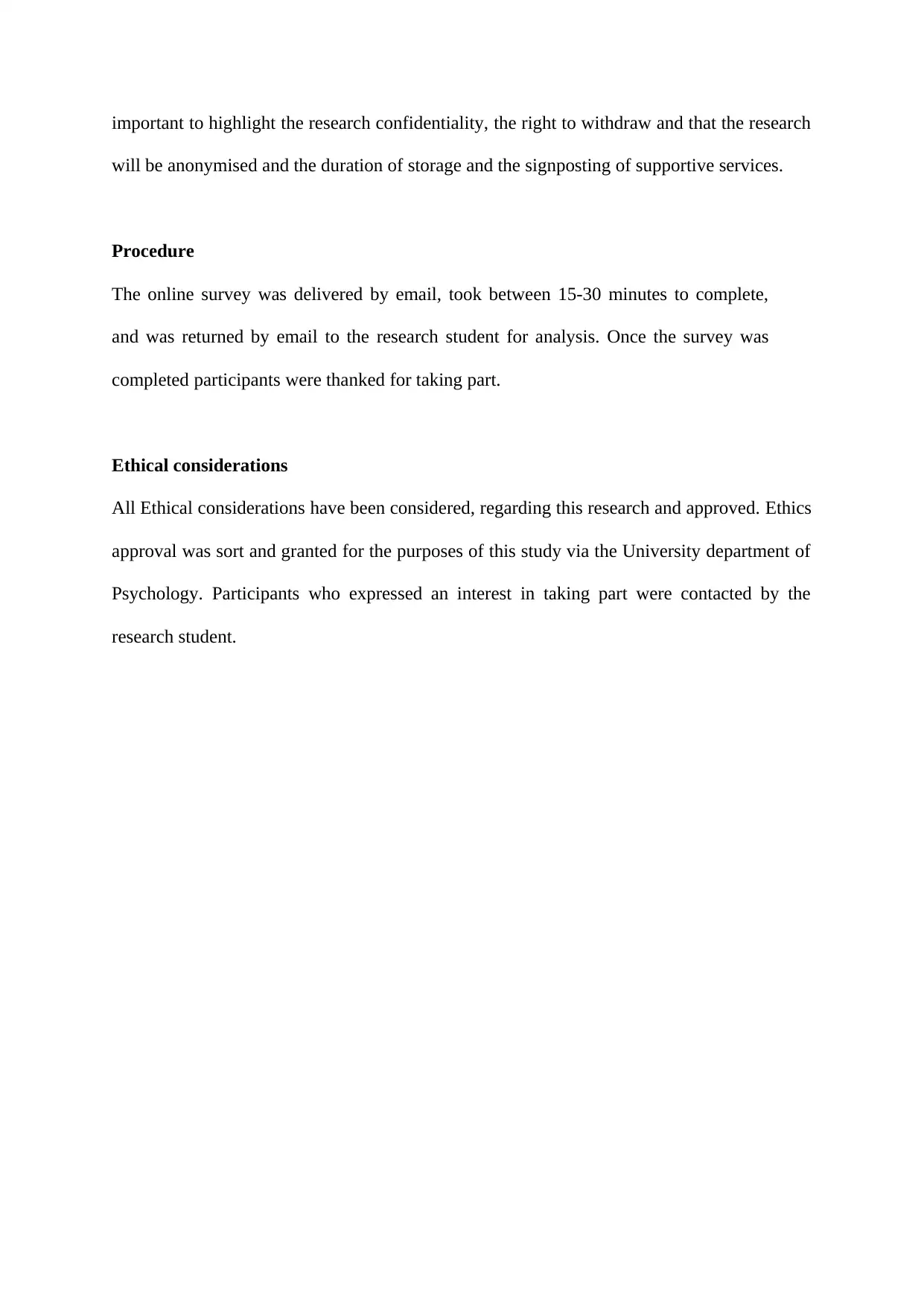
important to highlight the research confidentiality, the right to withdraw and that the research
will be anonymised and the duration of storage and the signposting of supportive services.
Procedure
The online survey was delivered by email, took between 15-30 minutes to complete,
and was returned by email to the research student for analysis. Once the survey was
completed participants were thanked for taking part.
Ethical considerations
All Ethical considerations have been considered, regarding this research and approved. Ethics
approval was sort and granted for the purposes of this study via the University department of
Psychology. Participants who expressed an interest in taking part were contacted by the
research student.
will be anonymised and the duration of storage and the signposting of supportive services.
Procedure
The online survey was delivered by email, took between 15-30 minutes to complete,
and was returned by email to the research student for analysis. Once the survey was
completed participants were thanked for taking part.
Ethical considerations
All Ethical considerations have been considered, regarding this research and approved. Ethics
approval was sort and granted for the purposes of this study via the University department of
Psychology. Participants who expressed an interest in taking part were contacted by the
research student.
⊘ This is a preview!⊘
Do you want full access?
Subscribe today to unlock all pages.

Trusted by 1+ million students worldwide
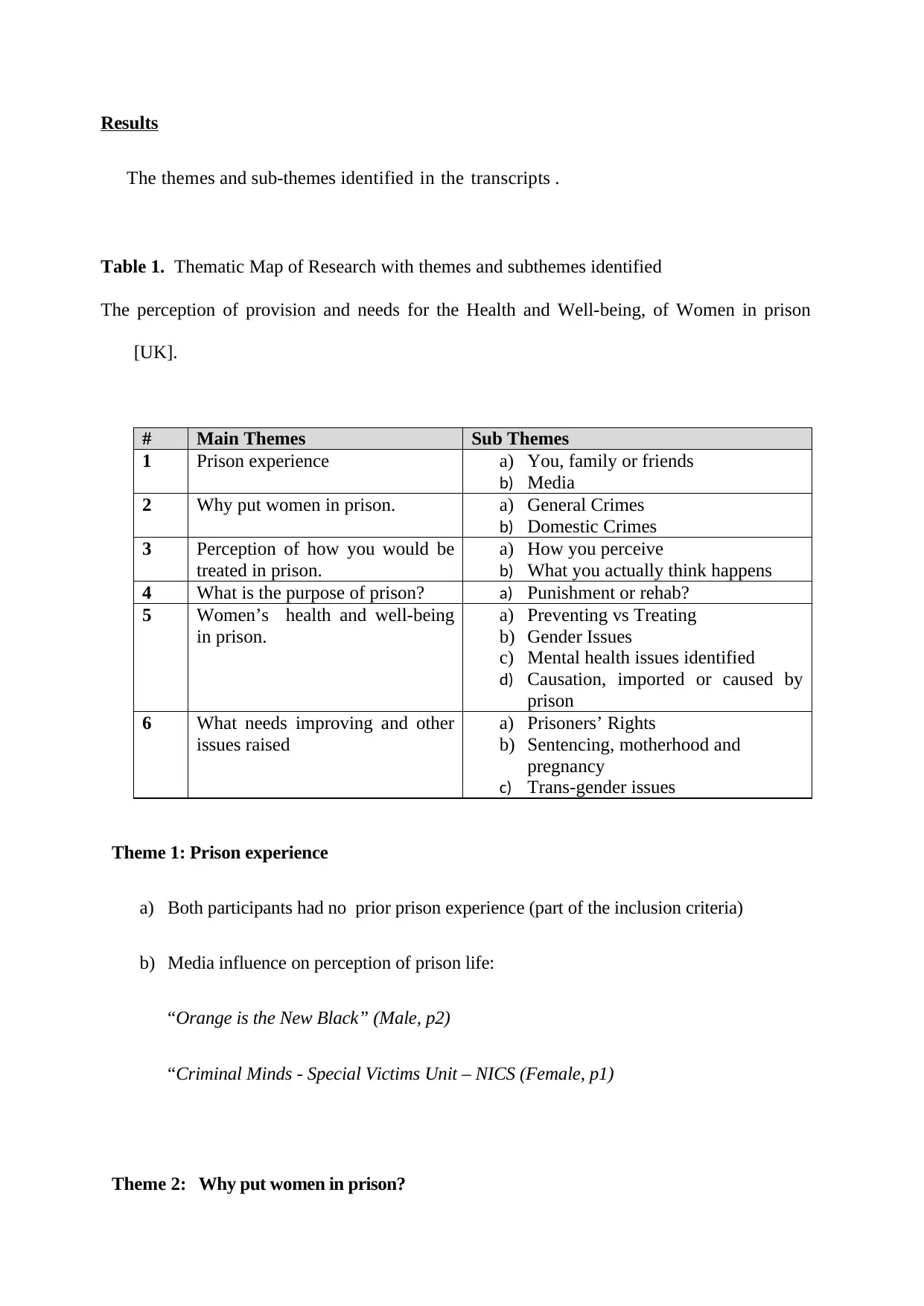
Results
The themes and sub-themes identified in the transcripts .
Table 1. Thematic Map of Research with themes and subthemes identified
The perception of provision and needs for the Health and Well-being, of Women in prison
[UK].
# Main Themes Sub Themes
1 Prison experience a) You, family or friends
b) Media
2 Why put women in prison. a) General Crimes
b) Domestic Crimes
3 Perception of how you would be
treated in prison.
a) How you perceive
b) What you actually think happens
4 What is the purpose of prison? a) Punishment or rehab?
5 Women’s health and well-being
in prison.
a) Preventing vs Treating
b) Gender Issues
c) Mental health issues identified
d) Causation, imported or caused by
prison
6 What needs improving and other
issues raised
a) Prisoners’ Rights
b) Sentencing, motherhood and
pregnancy
c) Trans-gender issues
Theme 1: Prison experience
a) Both participants had no prior prison experience (part of the inclusion criteria)
b) Media influence on perception of prison life:
“Orange is the New Black” (Male, p2)
“Criminal Minds - Special Victims Unit – NICS (Female, p1)
Theme 2: Why put women in prison?
The themes and sub-themes identified in the transcripts .
Table 1. Thematic Map of Research with themes and subthemes identified
The perception of provision and needs for the Health and Well-being, of Women in prison
[UK].
# Main Themes Sub Themes
1 Prison experience a) You, family or friends
b) Media
2 Why put women in prison. a) General Crimes
b) Domestic Crimes
3 Perception of how you would be
treated in prison.
a) How you perceive
b) What you actually think happens
4 What is the purpose of prison? a) Punishment or rehab?
5 Women’s health and well-being
in prison.
a) Preventing vs Treating
b) Gender Issues
c) Mental health issues identified
d) Causation, imported or caused by
prison
6 What needs improving and other
issues raised
a) Prisoners’ Rights
b) Sentencing, motherhood and
pregnancy
c) Trans-gender issues
Theme 1: Prison experience
a) Both participants had no prior prison experience (part of the inclusion criteria)
b) Media influence on perception of prison life:
“Orange is the New Black” (Male, p2)
“Criminal Minds - Special Victims Unit – NICS (Female, p1)
Theme 2: Why put women in prison?
Paraphrase This Document
Need a fresh take? Get an instant paraphrase of this document with our AI Paraphraser
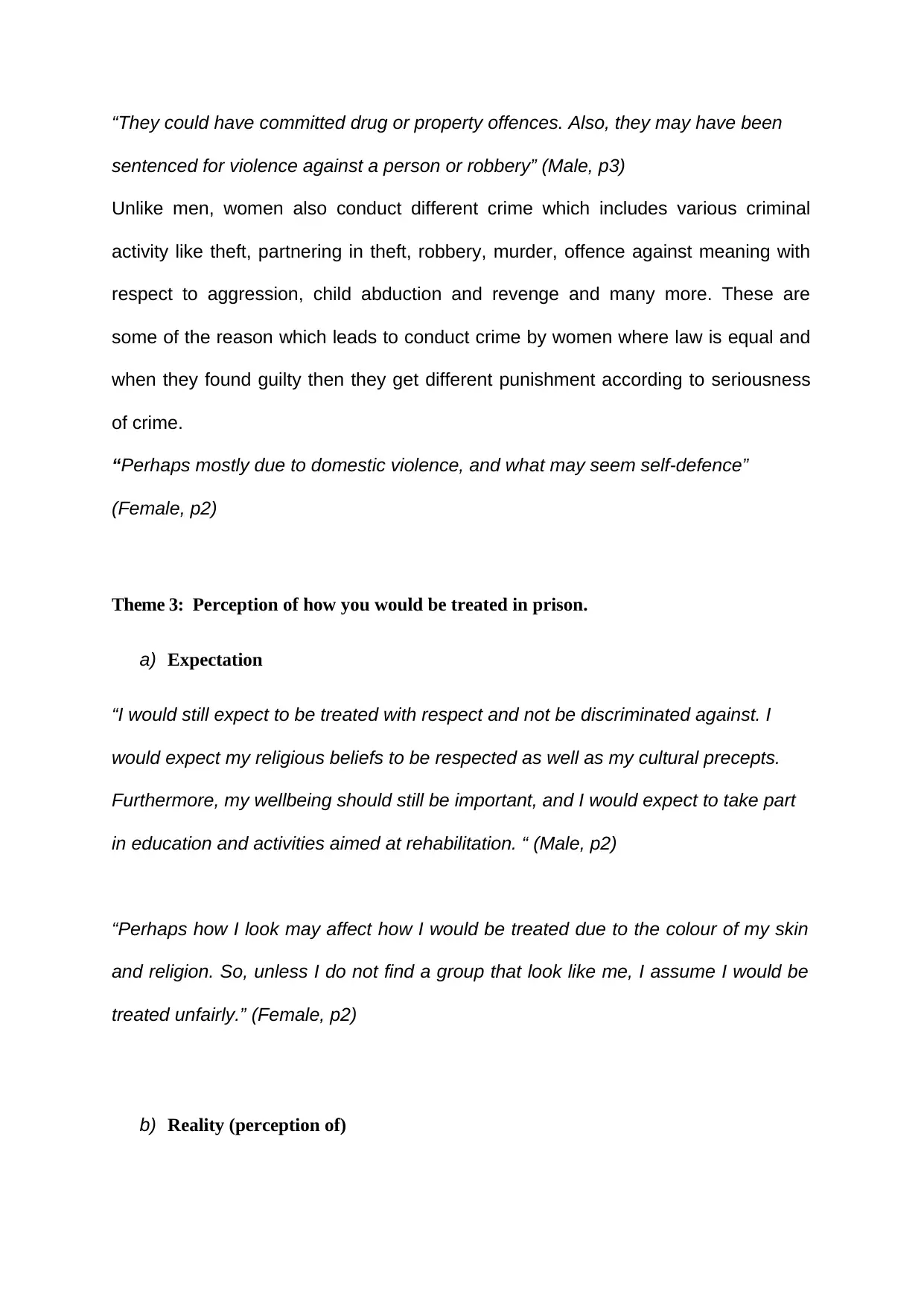
“They could have committed drug or property offences. Also, they may have been
sentenced for violence against a person or robbery” (Male, p3)
Unlike men, women also conduct different crime which includes various criminal
activity like theft, partnering in theft, robbery, murder, offence against meaning with
respect to aggression, child abduction and revenge and many more. These are
some of the reason which leads to conduct crime by women where law is equal and
when they found guilty then they get different punishment according to seriousness
of crime.
“Perhaps mostly due to domestic violence, and what may seem self-defence”
(Female, p2)
Theme 3: Perception of how you would be treated in prison.
a) Expectation
“I would still expect to be treated with respect and not be discriminated against. I
would expect my religious beliefs to be respected as well as my cultural precepts.
Furthermore, my wellbeing should still be important, and I would expect to take part
in education and activities aimed at rehabilitation. “ (Male, p2)
“Perhaps how I look may affect how I would be treated due to the colour of my skin
and religion. So, unless I do not find a group that look like me, I assume I would be
treated unfairly.” (Female, p2)
b) Reality (perception of)
sentenced for violence against a person or robbery” (Male, p3)
Unlike men, women also conduct different crime which includes various criminal
activity like theft, partnering in theft, robbery, murder, offence against meaning with
respect to aggression, child abduction and revenge and many more. These are
some of the reason which leads to conduct crime by women where law is equal and
when they found guilty then they get different punishment according to seriousness
of crime.
“Perhaps mostly due to domestic violence, and what may seem self-defence”
(Female, p2)
Theme 3: Perception of how you would be treated in prison.
a) Expectation
“I would still expect to be treated with respect and not be discriminated against. I
would expect my religious beliefs to be respected as well as my cultural precepts.
Furthermore, my wellbeing should still be important, and I would expect to take part
in education and activities aimed at rehabilitation. “ (Male, p2)
“Perhaps how I look may affect how I would be treated due to the colour of my skin
and religion. So, unless I do not find a group that look like me, I assume I would be
treated unfairly.” (Female, p2)
b) Reality (perception of)
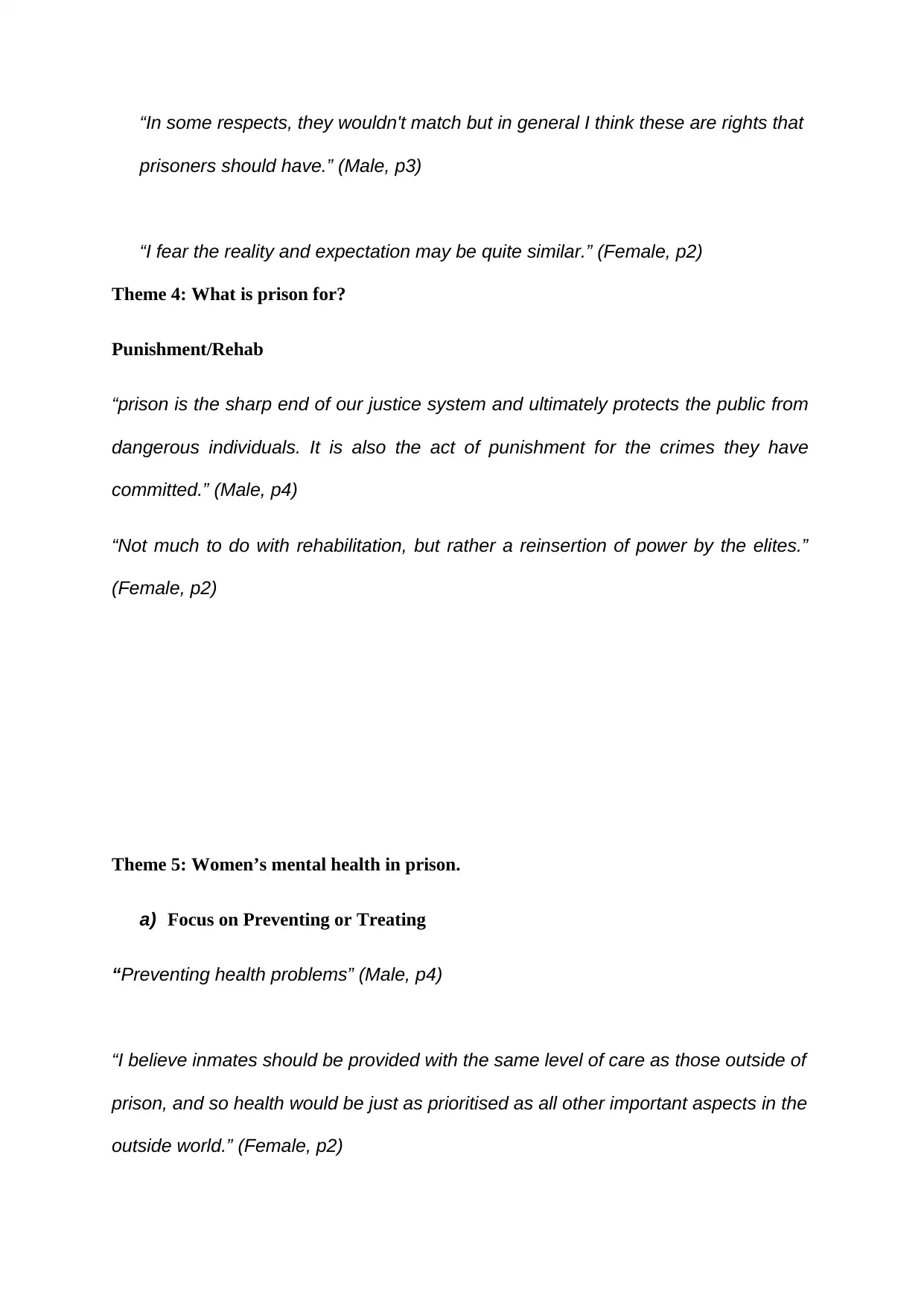
“In some respects, they wouldn't match but in general I think these are rights that
prisoners should have.” (Male, p3)
“I fear the reality and expectation may be quite similar.” (Female, p2)
Theme 4: What is prison for?
Punishment/Rehab
“prison is the sharp end of our justice system and ultimately protects the public from
dangerous individuals. It is also the act of punishment for the crimes they have
committed.” (Male, p4)
“Not much to do with rehabilitation, but rather a reinsertion of power by the elites.”
(Female, p2)
Theme 5: Women’s mental health in prison.
a) Focus on Preventing or Treating
“Preventing health problems” (Male, p4)
“I believe inmates should be provided with the same level of care as those outside of
prison, and so health would be just as prioritised as all other important aspects in the
outside world.” (Female, p2)
prisoners should have.” (Male, p3)
“I fear the reality and expectation may be quite similar.” (Female, p2)
Theme 4: What is prison for?
Punishment/Rehab
“prison is the sharp end of our justice system and ultimately protects the public from
dangerous individuals. It is also the act of punishment for the crimes they have
committed.” (Male, p4)
“Not much to do with rehabilitation, but rather a reinsertion of power by the elites.”
(Female, p2)
Theme 5: Women’s mental health in prison.
a) Focus on Preventing or Treating
“Preventing health problems” (Male, p4)
“I believe inmates should be provided with the same level of care as those outside of
prison, and so health would be just as prioritised as all other important aspects in the
outside world.” (Female, p2)
⊘ This is a preview!⊘
Do you want full access?
Subscribe today to unlock all pages.

Trusted by 1+ million students worldwide
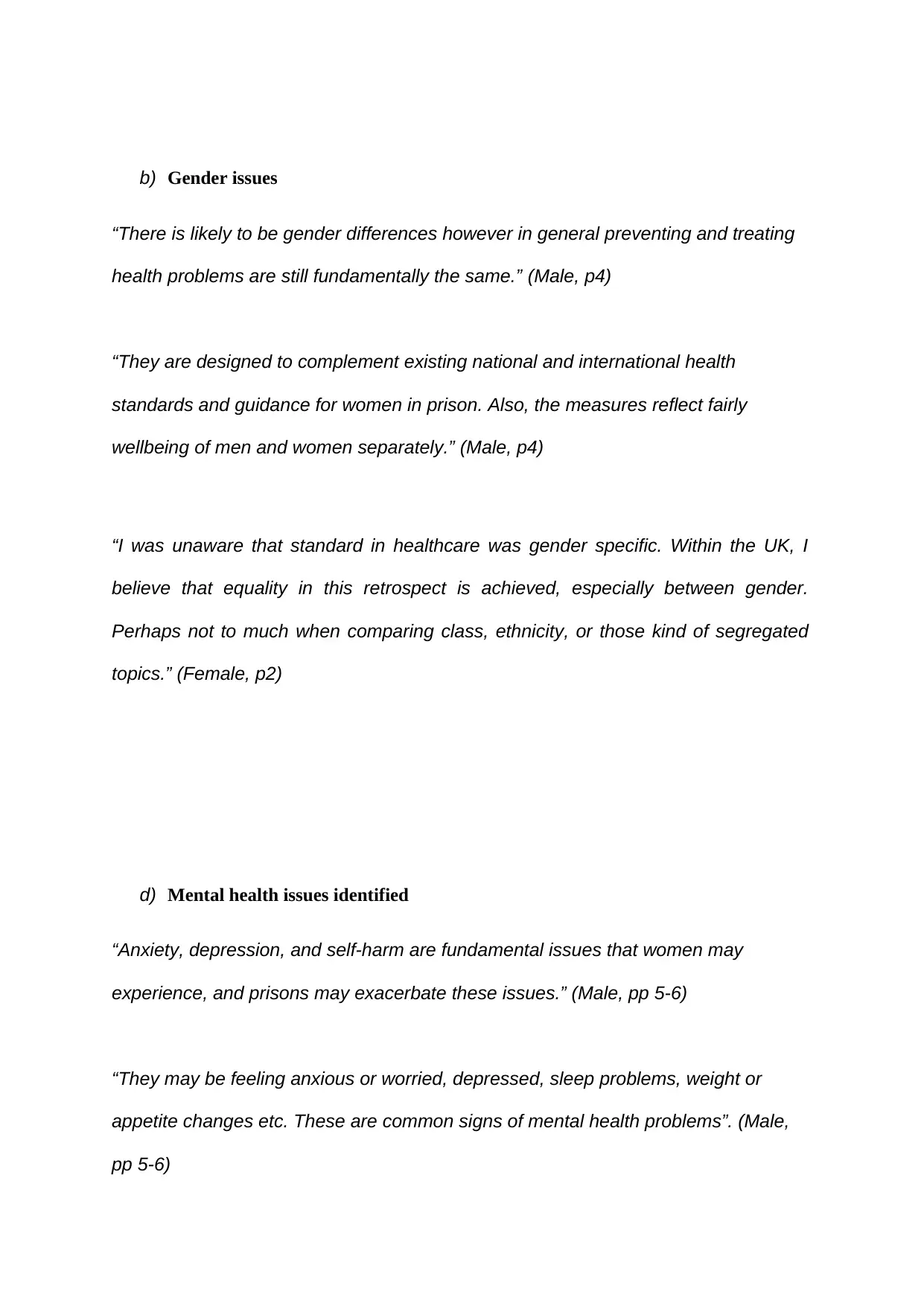
b) Gender issues
“There is likely to be gender differences however in general preventing and treating
health problems are still fundamentally the same.” (Male, p4)
“They are designed to complement existing national and international health
standards and guidance for women in prison. Also, the measures reflect fairly
wellbeing of men and women separately.” (Male, p4)
“I was unaware that standard in healthcare was gender specific. Within the UK, I
believe that equality in this retrospect is achieved, especially between gender.
Perhaps not to much when comparing class, ethnicity, or those kind of segregated
topics.” (Female, p2)
d) Mental health issues identified
“Anxiety, depression, and self-harm are fundamental issues that women may
experience, and prisons may exacerbate these issues.” (Male, pp 5-6)
“They may be feeling anxious or worried, depressed, sleep problems, weight or
appetite changes etc. These are common signs of mental health problems”. (Male,
pp 5-6)
“There is likely to be gender differences however in general preventing and treating
health problems are still fundamentally the same.” (Male, p4)
“They are designed to complement existing national and international health
standards and guidance for women in prison. Also, the measures reflect fairly
wellbeing of men and women separately.” (Male, p4)
“I was unaware that standard in healthcare was gender specific. Within the UK, I
believe that equality in this retrospect is achieved, especially between gender.
Perhaps not to much when comparing class, ethnicity, or those kind of segregated
topics.” (Female, p2)
d) Mental health issues identified
“Anxiety, depression, and self-harm are fundamental issues that women may
experience, and prisons may exacerbate these issues.” (Male, pp 5-6)
“They may be feeling anxious or worried, depressed, sleep problems, weight or
appetite changes etc. These are common signs of mental health problems”. (Male,
pp 5-6)
Paraphrase This Document
Need a fresh take? Get an instant paraphrase of this document with our AI Paraphraser
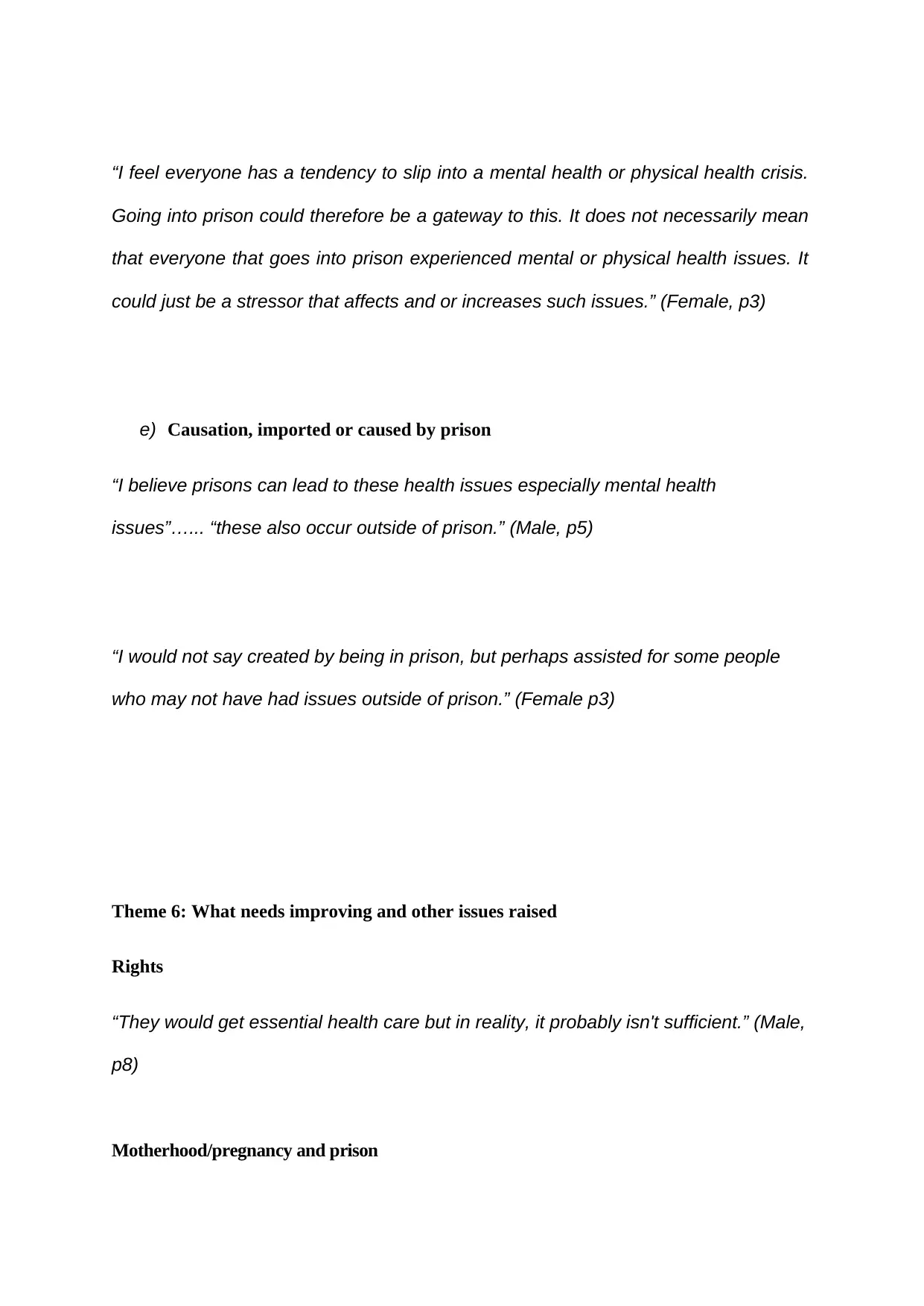
“I feel everyone has a tendency to slip into a mental health or physical health crisis.
Going into prison could therefore be a gateway to this. It does not necessarily mean
that everyone that goes into prison experienced mental or physical health issues. It
could just be a stressor that affects and or increases such issues.” (Female, p3)
e) Causation, imported or caused by prison
“I believe prisons can lead to these health issues especially mental health
issues”…... “these also occur outside of prison.” (Male, p5)
“I would not say created by being in prison, but perhaps assisted for some people
who may not have had issues outside of prison.” (Female p3)
Theme 6: What needs improving and other issues raised
Rights
“They would get essential health care but in reality, it probably isn't sufficient.” (Male,
p8)
Motherhood/pregnancy and prison
Going into prison could therefore be a gateway to this. It does not necessarily mean
that everyone that goes into prison experienced mental or physical health issues. It
could just be a stressor that affects and or increases such issues.” (Female, p3)
e) Causation, imported or caused by prison
“I believe prisons can lead to these health issues especially mental health
issues”…... “these also occur outside of prison.” (Male, p5)
“I would not say created by being in prison, but perhaps assisted for some people
who may not have had issues outside of prison.” (Female p3)
Theme 6: What needs improving and other issues raised
Rights
“They would get essential health care but in reality, it probably isn't sufficient.” (Male,
p8)
Motherhood/pregnancy and prison
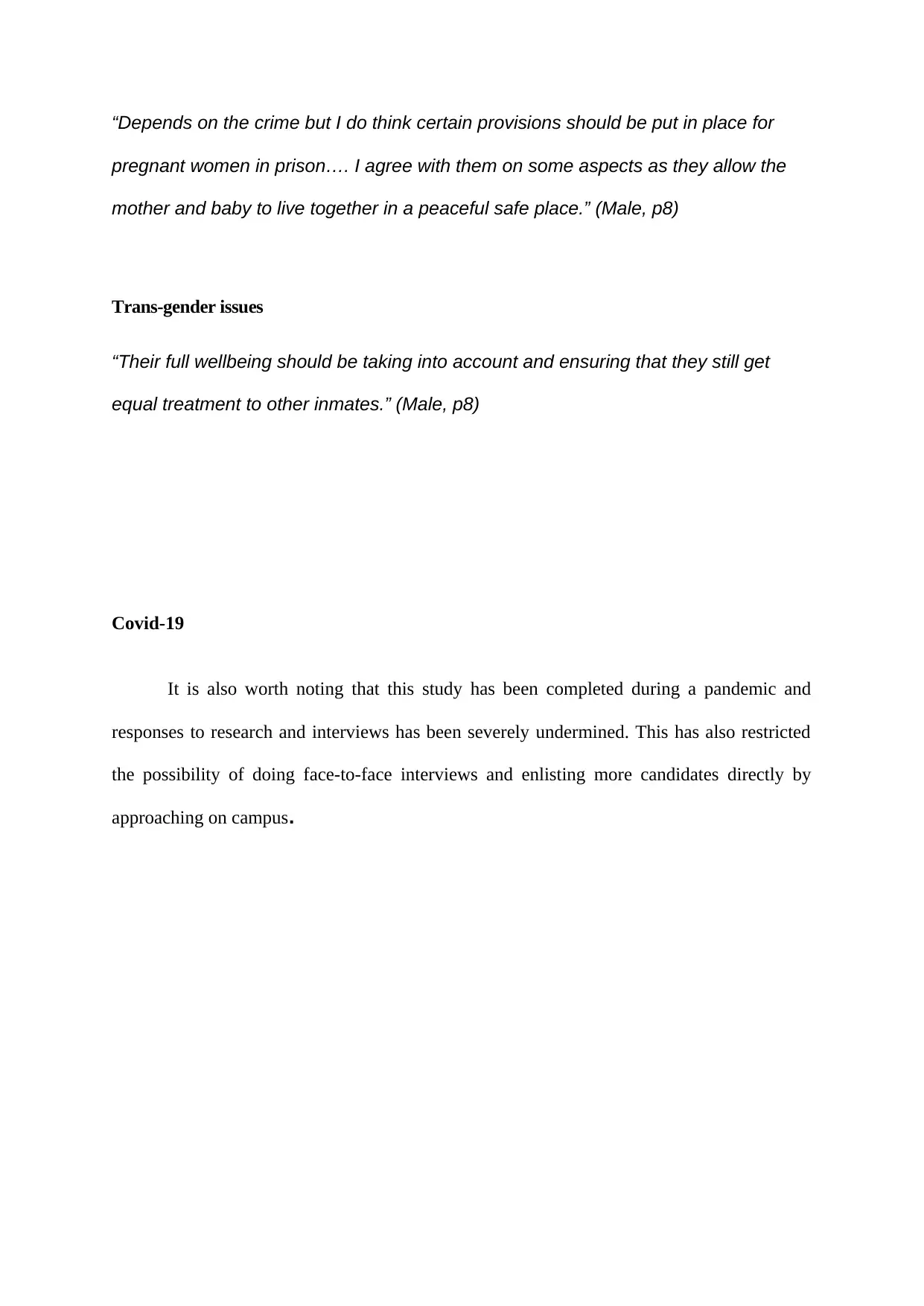
“Depends on the crime but I do think certain provisions should be put in place for
pregnant women in prison…. I agree with them on some aspects as they allow the
mother and baby to live together in a peaceful safe place.” (Male, p8)
Trans-gender issues
“Their full wellbeing should be taking into account and ensuring that they still get
equal treatment to other inmates.” (Male, p8)
Covid-19
It is also worth noting that this study has been completed during a pandemic and
responses to research and interviews has been severely undermined. This has also restricted
the possibility of doing face-to-face interviews and enlisting more candidates directly by
approaching on campus.
pregnant women in prison…. I agree with them on some aspects as they allow the
mother and baby to live together in a peaceful safe place.” (Male, p8)
Trans-gender issues
“Their full wellbeing should be taking into account and ensuring that they still get
equal treatment to other inmates.” (Male, p8)
Covid-19
It is also worth noting that this study has been completed during a pandemic and
responses to research and interviews has been severely undermined. This has also restricted
the possibility of doing face-to-face interviews and enlisting more candidates directly by
approaching on campus.
⊘ This is a preview!⊘
Do you want full access?
Subscribe today to unlock all pages.

Trusted by 1+ million students worldwide
1 out of 35
Your All-in-One AI-Powered Toolkit for Academic Success.
+13062052269
info@desklib.com
Available 24*7 on WhatsApp / Email
![[object Object]](/_next/static/media/star-bottom.7253800d.svg)
Unlock your academic potential
Copyright © 2020–2025 A2Z Services. All Rights Reserved. Developed and managed by ZUCOL.

